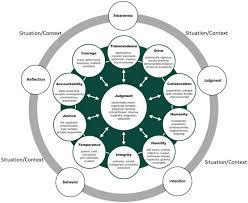Exploring Collaborative Decision Making Models: FAQs and Best Practices
- What is collaborative decision making?
- How can collaborative decision making improve productivity and efficiency?
- What are some of the most common collaborative decision making models?
- How do you facilitate effective collaboration in decision making?
- Are there any potential drawbacks to using a collaborative decision making model?
- What tools or techniques can be used to support collaborative decision making processes?
What is collaborative decision making?
Collaborative decision making is a process in which individuals or groups work together to make a decision. It involves sharing ideas, perspectives, and information in order to come up with the best possible solution.
In collaborative decision making, everyone involved has an equal say and the goal is to reach a consensus or agreement that satisfies everyone’s needs and interests. This approach can be particularly useful when dealing with complex issues or when there are multiple stakeholders involved.
Collaborative decision making can take many forms, from informal discussions to formal meetings with structured processes. It often involves brainstorming sessions, active listening, and open communication.
The benefits of collaborative decision making include increased engagement and buy-in from all parties involved, improved communication and understanding of different perspectives, and the potential for more creative solutions to emerge. However, it can also be time-consuming and may require compromise from all parties involved.
Overall, collaborative decision making is a powerful tool for reaching effective solutions that benefit everyone involved.
How can collaborative decision making improve productivity and efficiency?
Collaborative decision making involves a group of people working together to make a decision. This approach can improve productivity and efficiency in several ways:
Diverse perspectives: Collaborative decision making involves bringing together individuals with different backgrounds, experiences, and perspectives. This diversity can lead to more creative and innovative solutions that may not have been considered otherwise.
Increased buy-in: When people are involved in the decision-making process, they are more likely to feel invested in the outcome. This can lead to increased motivation and commitment to achieving the goals set forth by the group.
Better information sharing: Collaborative decision making allows for better information sharing among group members. This can lead to a more comprehensive understanding of the problem at hand and better-informed decisions.
More efficient problem-solving: By involving multiple people in the decision-making process, collaborative decision making can help identify potential roadblocks or challenges early on. This allows for more efficient problem-solving and can help avoid delays or setbacks down the line.
Improved communication: Collaborative decision making requires effective communication among group members. When done correctly, this approach can improve communication skills among team members, leading to better collaboration and overall team performance.
Overall, collaborative decision making can be an effective way to improve productivity and efficiency by leveraging diverse perspectives, increasing buy-in, improving information sharing, enabling efficient problem-solving, and enhancing communication skills among team members.
What are some of the most common collaborative decision making models?
There are several collaborative decision making models that are commonly used in various settings, including:
- Consensus decision making: This model involves a group of individuals working together to reach a decision that everyone can agree on. It requires open communication, active listening, and a willingness to compromise.
- Delphi method: This model involves a group of experts who participate in a series of rounds of discussion and feedback until a consensus is reached. It is often used in situations where there is no clear answer or when there are multiple options to consider.
- Nominal group technique: This model involves individuals working independently to generate ideas, which are then discussed and ranked as a group. It encourages equal participation and allows for individual creativity while still promoting collaboration.
- Six Thinking Hats: This model involves individuals wearing different “hats” or roles during the decision-making process, such as the role of the devil’s advocate or the role of the optimist. It encourages diverse perspectives and helps to overcome biases.
- Stepladder technique: This model involves adding members to a decision-making group one at a time in order to ensure that everyone has an equal opportunity to contribute and that individual biases are minimized.
These models can be adapted for use in various contexts and situations, depending on the needs and goals of the group involved in the decision-making process.
How do you facilitate effective collaboration in decision making?
Set clear objectives: Before beginning the collaboration process, it is important to set clear objectives for the decision-making process. This will help keep everyone on track and ensure that the decisions being made are in line with the overall goals of the group.
Establish ground rules: Establishing ground rules for collaboration can help ensure that everyone is on the same page and that all voices are heard. Make sure to discuss topics such as respect, communication, and how decisions will be made.
Involve all stakeholders: Inviting all relevant stakeholders to participate in the decision-making process helps ensure that all perspectives are taken into account when making decisions.
Encourage open dialogue: Encourage open dialogue between participants by asking questions and actively listening to each other’s opinions. This will help create an environment of trust and understanding which can lead to more effective collaboration and decision making.
5. Identify a leader: Identifying a leader or facilitator can help keep everyone focused on the task at hand and ensure that decisions are made in a timely manner. The leader should be impartial and able to remain neutral during discussions, while also ensuring that everyone’s opinion is heard and respected.
Are there any potential drawbacks to using a collaborative decision making model?
While collaborative decision making can be an effective approach, there are also potential drawbacks to consider. Here are a few:
- Time-consuming: Collaborative decision making can take more time than other decision-making models, as it requires input and agreement from all parties involved. This can sometimes lead to delays in decision making.
- Groupthink: Collaborative decision making can sometimes lead to groupthink, where the group may prioritize harmony and consensus over critical evaluation of ideas. This can result in suboptimal decisions being made.
- Conflict: Collaborative decision making involves working closely with others, which can sometimes lead to disagreements or conflicts. If not managed effectively, these conflicts can derail the decision-making process.
- Unequal participation: In collaborative decision making, some members of the group may be more vocal or dominant than others, which can result in unequal participation and influence over the final decision.
- Complexity: Collaborative decision making requires a high level of communication and coordination among all parties involved, which can become complex and difficult to manage in larger groups or organizations.
It’s important to consider these potential drawbacks when deciding whether collaborative decision making is the right approach for your particular situation.
What tools or techniques can be used to support collaborative decision making processes?
There are several tools and techniques that can be used to support collaborative decision making processes. Here are a few examples:
- Brainstorming: This is a popular technique that involves generating ideas in a group setting. It encourages open communication and the free flow of ideas, which can lead to more creative and innovative solutions.
- SWOT analysis: SWOT stands for strengths, weaknesses, opportunities, and threats. This technique involves analyzing the internal and external factors that can affect a decision. It helps to identify potential obstacles and opportunities, which can inform the decision-making process.
- Multi-criteria decision analysis (MCDA): MCDA is a structured approach that involves evaluating multiple options based on various criteria. It helps to prioritize options based on their relative strengths and weaknesses.
- Decision trees: This technique involves mapping out all possible outcomes of a decision in a visual format. It helps to identify the most likely outcomes and their associated risks.
- Consensus building: This technique involves working towards a common agreement or solution that everyone in the group can support. It requires active listening, compromise, and collaboration.
- Group decision support systems (GDSS): GDSS are computer-based tools that facilitate group decision making by providing a platform for sharing information, discussing options, and evaluating alternatives.
These tools and techniques can be used individually or in combination depending on the nature of the decision being made and the preferences of the group involved in the process.




